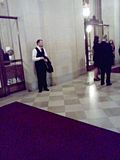 Over the weekend I saw Carmen at San Francisco Opera from a fine orchestra level seat. Conductor Nicola Luisotti charged into the overture before the applause died down. He uses a lot of over-sized gestures, & it was fun to watch him conduct the drum & cymbal crashes. The orchestra sounded bold & luxuriant though not as crisp as usual. I liked the phrasing & pure tone of the clarinet, & the violins sounded lush when playing the death motif. Act II began at an appropriately drowsy tempo that established the mood well.
Over the weekend I saw Carmen at San Francisco Opera from a fine orchestra level seat. Conductor Nicola Luisotti charged into the overture before the applause died down. He uses a lot of over-sized gestures, & it was fun to watch him conduct the drum & cymbal crashes. The orchestra sounded bold & luxuriant though not as crisp as usual. I liked the phrasing & pure tone of the clarinet, & the violins sounded lush when playing the death motif. Act II began at an appropriately drowsy tempo that established the mood well.Mezzo Anita Rachvelishvili was an Earth Mother Carmen. Her voice is dark, chesty & dramatic. I especially liked her dusky singing in the fortune telling scene in act III. As Don José, tenor Thiago Arancam had bright & secure high notes, but his performance did not feel very impassioned. Baritone Paulo Szot seems to make a sturdy sound, but his voice did not carry well, so his Escamillo was not very assertive. Soprano Sara Gartland has a strong, hard-edged voice, & her Micaëla came across as firm. Susannah Biller & Cybele Gouverneur sang & acted attractively as the gypsy girls Frasquita & Mercédès. In fact, the entire cast is quite good-looking.
The production is the familiar one by Jean-Pierre Ponnelle, with shallow, frontal sets fitting into a tall, sun-bleached wall. It uses spoken French dialogue instead of recitative, for the most part. The children's chorus was well-prepared & enthusiastic. One very small girl looked like she was 5 years old! In the final showdown between Carmen & Don José, Carmen more or less just stands there waiting to be killed. Mr. Arancam had a little trouble pulling out his switchblade, but he had no problem ripping open his shirt moments later. The orchestra level audience gave Ms. Rachvelishvili a standing ovation. The lady next to me enjoyed the show very much, even conducting along during the Toreador Song. My opera companion was less enthused & laughed derisively at every reprise of the tune.
§ Carmen
Georges Bizet
San Francisco Opera
Conductor: Nicola Luisotti
Production & Set Designer: Jean Pierre Ponnelle
Director: Jose Maria Condemi
Moralès: Trevor Scheunemann
Micaëla: Sara Gartland
Don José: Thiago Arancam
Zuniga: Wayne Tigges
Carmen: Anita Rachvelishvili
Manuelita: Dvora Djoraev
Frasquita: Susannah Biller
Mercédès: Cybele Gouverneur
Escamillo: Paulo Szot
Lillas Pastia: Yusef Lambert
Le Dancaïre: Timothy Mix
Le Remendado: Daniel Montenegro
A guide: Gabriel Laude
Sun 11/20/11 2:00pm
War Memorial Opera House
















